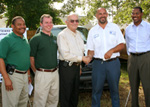 
The Natural Resources Conservation Service —
Helping People Help the Land.
Subscribe to NRCS This Week
| NRCS This Week Articles Index | NRCS
This Week Archives |
Contact Us |
Where to Get Information
|
eNotes from
NACD |
 TSP Express
(RequiresAdobe Acrobat.) TSP Express
(RequiresAdobe Acrobat.)

Alabama
 Pre-Post
Hurricane EWP Work in the Yellowhammer State Pre-Post
Hurricane EWP Work in the Yellowhammer State
NRCS Regional Assistant Chief — East Dick Coombe was in Alabama recently
to view Emergency Watershed Protection (EWP) Program sites there including those
on the Poarch Band of Creek Indian reservation.
Minnesota
 Cooperative
Brushland Conservation: Keeping the Sharptails Dancing Cooperative
Brushland Conservation: Keeping the Sharptails Dancing
Thanks to a cooperative effort involving NRCS and the Minnesota Department of Natural
Resources (MDNR), conservation management of brushland habitat under both public
and private ownership is making remarkable progress towards restoring habitat
for the sharp-tailed grouse.
Mississippi
 Mississippi
Spells Cars: N-R-C-S Mississippi
Spells Cars: N-R-C-S
NRCS and The Irrigation Association
recently welcomed USDA Deputy Under Secretary for Natural Resources and
Environment Merlyn Carlson to Mississippi for an event proclaiming July as
Smart Irrigation
Month. The Byron Seward farm in Yazoo County, Mississippi, was the site
for the proclamation issued by Carlson on behalf of Secretary of Agriculture Mike
Johanns.
Smart Irrigation Month in the
Magnolia State
Texas
 Agricultural
Safety For Kids Agricultural
Safety For Kids
Farm safety is always a concern for the families and the people who live in the
farming communities. It’s also a vital concern among laborers and their
children working in the fields and around farming equipment. Farm Safety
Day in Texas links to these issues and makes learning fun.
Connect to
NRCS' State
News,
Newsroom, and
News Releases!


Secretary Johanns
Declares July as Smart Irrigation Month
 NRCS
Booth a Hit at World Congress of Soil Science NRCS
Booth a Hit at World Congress of Soil Science
A unique exhibit, Soils - the Foundation of Life was produced especially
for the
18th World
Congress of Soil Science and highlighted NRCS technologies and data
resources used for soil survey and resource assessment.
See images of NRCS activities during the event.
Links...
This item requires
Windows Media
Player
 USDA
Video News Release Highlights the World Congress of Soil Science USDA
Video News Release Highlights the World Congress of Soil Science

 PRISM
Reveals Statewide Climate Averages PRISM
Reveals Statewide Climate Averages
Have you ever been asked “What’s the average precipitation or temperature
for your state or county?" In today’s world of Geographical Information Systems
(GIS) technology, the Parameter-elevation Regression on Independent Slopes
Model’s (PRISM) spatial data is well-suited to performing calculations that
would normally have been impossible only a generation ago.

Click Here for the Latest NRCS Directives
The U.S. Department of Agriculture (USDA) prohibits discrimination in all its
programs and activities on the basis of race, color, national origin, age,
disability, and where applicable, sex, marital status, familial status, parental
status, religion, sexual orientation, genetic information, political beliefs,
reprisal, or because all or a part of an individual's income is derived from any
public assistance program. (Not all prohibited bases apply to all programs.)
Persons with disabilities who require alternative means for communication of
program information (Braille, large print, audiotape, etc.) should contact
USDA's TARGET Center at (202) 720-2600 (voice and TDD).
To file a complaint of discrimination write to USDA, Director, Office of Civil
Rights, 1400 Independence Avenue, S.W., Washington, D.C. 20250-9410 or call
(800) 795-3272 (voice) or (202) 720-6382 (TDD). USDA is an equal opportunity
provider and employer.
| 

